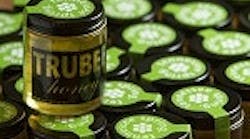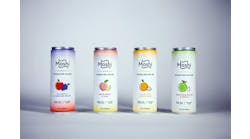As organic and natural food products continue to multiply — and become more upscale — brand owners are using package graphics, structures and materials to differentiate their products both from conventional products and from other organic/natural offerings.
For TruBee Honey, which produces raw, unpasteurized honey, glass packaging with distinctive graphics communicates the brand's upscale personality as well as the honey's artisanal quality. The beekeepers at TruBee have been making honey for a decade and launched the TruBee brand two years ago.
"Our target market is people who want a pure, authentic product that is as close to nature as possible," explains Laura Kimball, "queen bee" at TruBee Honey (www.truebeehoney.com), Arrington, Tenn. "That's what we sell, and we felt like glass is the next best thing to just pouring the honey straight out of the hive."
The glass jars also protect the honey from package-related contamination. Product integrity is TruBee's top priority, "and glass seemed like the right choice to maintain that. People who want the high-end honey products don't want to buy in plastic," Kimball says. "I think there's a lot of suspicion about materials from plastic leaching into food."
She adds, "For us [a] glass jar speaks to a high-end customer and provides that food safety that people are looking for. There's no question about glass. People know that glass … doesn't leach into the food."
For many organic food processors, reducing the environmental impact of their products and packaging is a key piece of the mission statement. As an example, Pacific Natural Foods (www.pacificfoods.com), Tualatin, Ore., is working toward a zero-waste-to-landfill goal. Reducing food-contaminated packaging waste from operations has been an important part of that effort.
The company makes and fills organic products such as soy milk, soup and broth using aseptic fillers and packaging material from Tetra Pak Inc., Vernon Hills, Ill. Changing over the aseptic fillers between runs of different products and flavors generates a certain amount of wasted packaging material.
Until fairly recently, the company simply loaded that waste material into a 30-yard compactor and sent the waste to a landfill. But now the compactor is gone, and Pacific Natural uses a machine it calls the "pack crusher" to dewater, or clean, the waste packaging material and crush it in preparation for sale to recycling companies. The company worked with a local equipment maker to build the custom machine.
In addition to improving the company's environmental performance, the pack crusher is helping it financially. "We're taking what was traditionally a cost center, our waste management, and bringing some profit in," says Rory Schmick, Pacific Natural's director of sustainability and environmental affairs.
"We estimate that we're saving between $100,000 and $120,000 a year in avoided landfill tipping fees by keeping that material out of the landfill," he adds. "And then by preparing it and selling into the recycling markets [for plastic films, metals, rigid plastic and various grades of fiber] we're earning between $65,000 and $75,000 a year."
Pacific Natural puts the profit back into its recycling infrastructure, which includes three new full-time employees who collect and prepare materials for recycling.
It's a "wonderful example of the triple bottom line" of sustainability, Schmick says, with a combination of environmental benefit, economic benefit and social benefit (via job creation).
A secondary priority for TruBee was packaging that could be reused, so the company has started a rebate program in which consumers receive a credit toward their next TruBee purchase when they return an empty TruBee jar. TruBee sterilizes and refills the returned jars.
In addition to helping the company reduce the carbon footprint of its packaging, jar reuse and recyclability are very attractive to the company's target market. In a survey of natural and organic shoppers conducted by EcoFocus Worldwide LLC (www.ecofocusworldwide.com), St. Petersburg, Fla., 73 percent of respondents said they try to buy products in packaging that's refillable or reusable, and 78 percent try to buy products in recyclable packaging.
From a marketing perspective, TruBee's package graphics and clear product view display the product's quality and show that the brand has nothing to hide. The stencil-like logo uses a black rectangle to frame the TruBee Honey name. The letters in the name are not inked, so the honey's golden color is visible behind them.
"We wanted the idea of transparency to translate into the product on the shelf. We welcome people to come and look at our hives and see what beekeeping is all about, and we want the product to reflect … authenticity and the integrity," Kimball says. "You can hold it up to the light. You can see pollen floating around, the occasional piece of beeswax. You can see what you're about to get, and you can see how good it is."
Owens-Illinois Inc. (www.o-i.com), Perrysburg, Ohio, supplies TruBee's round, straight-sided 6- and 12-oz. screen-printed jars.
Little Duck Organics
As in all parts of the grocery store, organic offerings continue to shape the baby-food aisle. To make sure Little Duck Organics Tiny Fruits, a snack food for kids six months and older, didn't get lost in the shuffle, the brand owner created tongue-in-cheek package graphics and chose a resealable stand-up pouch instead of a rigid package.
The pouch holds one ounce of lightweight freeze-dried fruit, enough for four servings. "It's the perfect fit for a mom on the go, because it's a soft pack. You can easily put it in a diaper bag or purse," says Zak Normandin, chief executive officer and founder of New York-based Little Duck Organics (www.littleduckorganics.com). "With the resealable zip, you don't have to use it all in one serving, [plus] it doesn't take up a lot of space and it has all the same nutritional benefits as fresh fruit."
In addition, Normandin says the pouch "feels nice in your hands. It feels like a quality product, and that's what we want." The pouch material is polyethylene terephthalate (PET), which is coated on the product-facing side with a Saran polymer that keeps the product fresh. The product line currently comprises four flavors: Apple & Banana, Strawberry & Mango, Blueberry & Apple and Pineapple & Mango.
The graphics incorporate a vertical window across the bottom of the pouch. Like TruBee, Little Duck wants consumers to see what they're getting. "We've really made an effort to make sure the end product that's going to the consumer is the best possible quality," Normandin says. "Having a … window on the front speaks to that, and it shows that this is all you're getting in this bag. It's just apples and blueberries, or it's just strawberries and mangoes."
The combination of package structure and graphics enhances Little Duck's differential advantage. Normandin concludes: "There are a lot of different organic products out there, but the way … we're going to differentiate is through the brand and through the packaging."
GoPicnic Brands
The challenge for Chicago-based GoPicnic Brands Inc. (www.gopicnic.com), when it initiated a rebranding and packaging redesign for its on-the-go meals, included many facets. In addition to conveying the products' healthful attributes and the line's all-natural and other special-diet offerings, the packaging needed to communicate to first-time consumers what the product is: a shelf-stable, ready-to-eat boxed meal that requires no preparation.
In addition to quickly communicating the GoPicnic product concept, the new package design needed to highlight the products' nutritional qualities and features like "vegan," "kosher" and "gluten-free" (depending on the product). The 14 SKUs in the product line include many all-natural products; among these are the four SKUs in the GoPicnic Gold Star sub-brand, which is sold at Whole Foods Market and other natural-foods stores.
"It's a lot of information to include on the package, but all of it is fairly critical to the consumer's understanding of what the concept is," says Julia Stamberger, GoPicnic's pres//CEO. She adds that the package design's communications architecture had to ensure "that someone who had never encountered the product before understood what it was and how it functioned, so that within a couple seconds the value proposition jumped off the packaging."
To do so, the redesign features high-quality photography of the product's individual items all arranged on a plate. The background is a picnic-inspired gingham print, and text immediately above the food image says "ready-to-eat meal." A banner across the bottom of the carton communicates all-natural and special-diets information, plus nutritional content. An illustrated icon, also on the banner, reads: "5 individually-wrapped delights. 1 complete meal."
The package design "celebrates the brand's wholesomeness through photography and ingredient call-outs and instills confidence through the assurance of calorie control, protein, fiber and the ‘free-ofs' — gluten-free, all-natural, vegan and kosher," explains Yadim Medore, principal of Pure Branding Inc. (www.purebranding.com), Northampton, Mass. Pure Branding was responsible for the research, strategy and execution of the GoPicnic package redesign.
Medore adds that retailer pick-up has been "phenomenal" for the rebranded product line, with distribution through natural-foods stores, conventional grocers, mass merchandisers, convenience stores, drug stores, club stores, specialty retailers and airport stores. "We have never worked with a brand that's been accepted into so many channels simultaneously," he says. "It's incredible."


